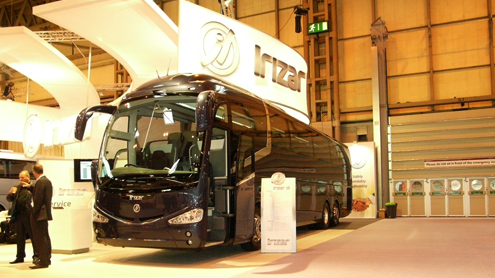
By Doug Jack
The exhibition season was in full swing in Europe toward the end of 2012 with the FIAA in Madrid, Spain and Euro Bus Expo in Birmingham, UK.

The show in Spain was strong despite the country’s severe financial problems. Many of the provincial governments borrowed heavily and are now cutting back severely on investment in new city buses. The market has traditionally relied on a combination of chassis, mainly imported, with locally built bodywork. That is coming under a strong challenge. The Daimler Buses stand was full of complete German and Turkish-built buses and coaches.
Times have become so hard that some of the domestic builders did not attend. There was a feeling that a number of manufacturers will fall by the wayside. Fortunately Spain is still a very popular tourist destination, so demand for coaches remains reasonable, although not at previous levels.
Irizar launches i3
One Spanish company, the Irizar Group, is very strong and healthy.CEO José Manuel Orcasitas said the Irizar Group had a record turnover of more than $650 million in 2011 and would be capable of maintaining that in 2012. The company had a large stand and chose the occasion to launch its new i3. This is Irizar ‘s first vehicle for use either as a transit bus or more comfortably appointed for suburban and short interurban routes.
Irizar has now delivered its integral coach range to seven European markets, outside Spain. The i6 is a particularly stylish and comfortable coach. The company said it was at an advanced stage in a project to introduce its integral models to the United States. There will be two launch prototypes. One bus measures in at 40 feet long by 11 feet, 6 inches on two axles and the other at 45 feet by 12 feet, 2 inches on three axles. The first pre-series stage will take place at the main factory in Spain, with volume production following from Irizar’s Mexican subsidiary.
UNVI is another Spanish bodybuilder keeping its production at normal levels, thanks to strong export activities. The company has carved out a number of niches, including open-top double deck buses for city sightseeing. Until now these have been built with steel framing, but UNVI has developed its own aluminium structure specifically for open-top layouts.
Alexandre Lecompte, sales director, said that one of their projects was to build this model on a modified Freightliner chassis for the US market. UNVI also makes a wide range of conversions on the Mercedes-Benz Sprinter, sold in your country with a Dodge badge. Alexander said that conversion kits were being supplied from Spain to factories in the US and Canada for local completion.

Business in the UK
In contrast, the United Kingdom market was much more buoyant in 2012, boosted
to some extent by extra demand ahead of the Olympic Games. Alexander Dennis (ADL), the largest manufacturer, introduced a new version of its popular Enviro500 tri-axle double-deck bus, mainly for export markets including the US and Canada. Models for the Hong Kong market are normally built to a height of 14 feet, 6 inches, but a new Lo Height version at 13 feet, 7 inches is also available for North American customers who want buses that can circulate without special dispensation.
The chassis and body teams worked very closely on the new Enviro500 to integrate the structures, avoiding duplication of metalwork, while also achieving improved accessibility and reliability. Moving the Cummins engine a few inches from the center line at the rear has achieved greater headroom at the back of the lower deck. One example of the clever packaging is the location of the fuel tank, laid diagonally in otherwise wasted space underneath the staircase.
When Colin Robertson joined Alexander Dennis as CEO in March 2007, the annual turnover was around $270 million. He reckoned that would rise to $760 million in 2012, a rate of growth almost unknown in bus manufacturing in the Western world.
Stagecoach started Megabus.com in the United Kingdom. On the busiest routes, the 49 foot long tri-axle single-deck coaches have proved highly successful. Taking it one stage further, Volvo and Plaxton are combining to build a coach almost 13 feet high with a lower deck compartment for a driver, four passengers and a wheelchair user who can gain access to the vehicle without the need for an expensive lift.
Another 71 passengers can ride on an upper deck running the entire length of the vehicle. It was finished to a very high standard, with luxury seats, free Wi-Fi and a washroom mounted below the main deck, reached by a second staircase. An initial fleet of 11 vehicles entered service before the end of 2012, to be followed by a further 11 in 2013.

The government has stimulated the introduction of hybrid, gas-fueled and all-electric buses with funding that pays most of the difference in price compared with a standard diesel bus. MAN handed over the first of a fleet of CNG buses to Arriva and there were also two all-electric midibuses on display.
Over the years, by their very nature, all exhibitions change. We have seen tremendous growth in smart ticketing systems and also diagnostics. Smartcards make services more attractive to passengers because they reduce the time spent at bus stops. Diagnostics improve reliability and economy, important factors with the price of fuel on this side of the Atlantic. BR
Doug Jack is with Transport Resources in the United Kingdom.
